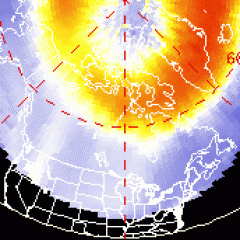~ Space Weather Update~ 2 M Class Flares [1]
WEEKEND AURORAS? A solar wind stream is expected to brush against Earth's magnetic field on April 6-7, possibly causing geomagnetic disturbances around the poles. Arctic sky watchers should be alert for auroras beaming through the waxing twilight of northern spring. Aurora alerts: text [2], voice [3].
INCOMING ACTIVE REGION: An active region on the farside of the sun is about to rotate onto the Earthside of the sun. It announced itself on April 5th around 0700 UT with a C2-class [4] solar flare that hurled material over the sun's eastern limb. NASA's Solar Dynamics Observatory recorded the extreme UV glow of the blast:
Quickly following that eruption came another even stronger one: An M2-class [4] flare (image [6]) at 1750 UT.
Clearly, this incoming region has the potential to stir up significant space weather. It may be a few days, however, before it becomes geoeffective. Stay tuned for updates as the blast site turns toward Earth. Solar flare alerts: text [2], voice [3].
Realtime Space Weather Photo Gallery [7]
OMG: On April 4th, in the western sky at sunset, Comet Pan-STARRS made a photogenic flyby of the Andromeda galaxy. Amateur astronomer Pavel Smilyk of Syktyvkar, Russia, photographed the pair at the hour of closest approach:
"This is a 27 x 2 minute guided exposure I made using a Canon 1100Da digital camera," says Smilyk. "We had very clear skies."
In this deep exposure, the comet's dusty tail appears to touch the galaxy's outermost spiral arms. In fact, no physical contact occured; the comet is still in the solar system while Andromeda is 2.5 million light years away.
The comet and galaxy are parting now, but slowly, so they will remain a close pair for cameras and wide-field telescopes for several nights to come. Browse the gallery for more close-up images [9] of the ongoing conjunction.
More about Pan-STARRS: NASA video [10], 3D orbit [11], ephemeris [12], light curves [13].
Realtime Comet Photo Gallery [9]
VENUS AND MARS CONVERGE: Venus and Mars are converging for a close encounter, but don't bother looking because the conjunction is happening in broad daylight. The Solar and Heliospheric Observatory (SOHO) took this picture of the planets only a few degrees from the Sun on April 5th:
At closest approach on April 6th, Venus and Mars will be only 1o apart.
After that, Mars will move even closer to the sun, which could limit NASA's contact with Mars rovers and orbiters. According to a NASA press release [15], "The sun can easily disrupt radio transmissions during the near-alignment. To prevent an impaired command from reaching an orbiter or rover, mission controllers at the Jet Propulsion Laboratory are preparing to suspend sending any commands to spacecraft at Mars for weeks in April. Transmissions from Mars to Earth will also be reduced." Mars will be at its closest to the sun, a slim 0.4 degrees on April 17th.
The ongoing dance of the sun and planets is invisible to the human eye, but coronagraphs can see the show. Join SOHO for a ringside seat [16].
Realtime Space Weather Photo Gallery [7]
Realtime Aurora Photo Gallery [17]
Realtime Noctilucent Cloud Photo Gallery [18]
[previous years: 2003 [19], 2004 [20], 2005 [21], 2006 [22], 2007 [23], 2008 [24], 2009 [25], 2011 [26]]
Potentially Hazardous Asteroids (PHAs [27]) are space rocks larger than approximately 100m that can come closer to Earth than 0.05 AU. None of the known PHAs is on a collision course with our planet, although astronomers are finding new ones [28] all the time.
![]()
![]()
Recent & Upcoming Earth-asteroid encounters:
Asteroid
2013 EL89 [29]
2013 FB8 [30]
2010 GM23 [31]
2005 NZ6 [32]
2001 DQ8 [33]
2004 BV102 [34]
1998 QE2 [35]
2000 FM10 [36]
2002 KL3 [37]
1999 WC2 [38]
2006 RO36 [39]
![]()
Notes: LD means "Lunar Distance." 1 LD = 384,401 km, the distance between Earth and the Moon. 1 LD also equals 0.00256 AU. MAG is the visual magnitude of the asteroid on the date of closest approach

![]()
Solar wind
speed: 313.3 km/sec
density: 5.9 protons/cm3
explanation [40] | more data [41]
Updated: Today at 0304 UT
![]()
X-ray Solar Flares
6-hr max: M1 1800 UT Apr05
24-hr: M2 1748 UT Apr05
explanation [4] | more data [42]
Updated: Today at: 2359 UT
![]()
![]()
![]()
Daily Sun: 05 Apr 13
![]()
![]()
Sunspot AR1713 is experiencing a growth spurt, but it is not yet producing significant flares. Credit: SDO/HMI
![]()
![]()
![]()
Sunspot number: 119
What is the sunspot number? [44]
Updated 05 Apr 2013
Spotless Days
Current Stretch: 0 days
2013 total: 0 days (0%)
2012 total: 0 days (0%)
2011 total: 2 days (<1%)
2010 total: 51 days (14%)
2009 total: 260 days (71%)
Since 2004: 821 days
Typical Solar Min: 486 days
Update 05 Apr 2013
The Radio Sun
10.7 cm flux: 129 sfu
explanation [45] | more data [46]
Updated 05 Apr 2013
![]()
![]()
![]()
Current Auroral Oval:
![]()
Switch to: Europe, USA, New Zealand, Antarctica
Credit: NOAA/POES
![]()
![]()
![]()
Planetary K-index
Now: Kp= 1 quiet
24-hr max: Kp= 1 quiet
explanation [48] | more data [49]
![]()
Interplanetary Mag. Field
Btotal: 8.3 nT
Bz: 5.9 nT north
explanation [50] | more data [51]
Updated: Today at 0307 UT
![]()
![]()
![]()
Coronal Holes: 05 Apr 13
![]()
![]()
Solar wind flowing from this coronal hole should reach Earth on April 6-7. Credit: SDO/AIA.
Category:
- Ground Crew Updates [53]





